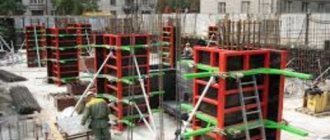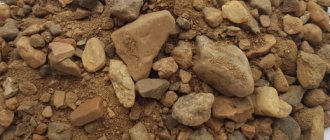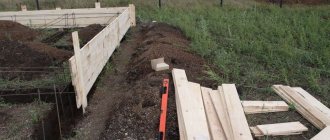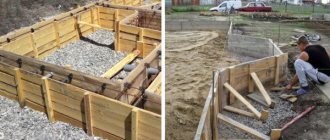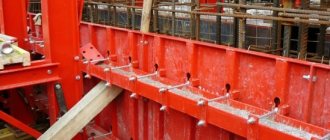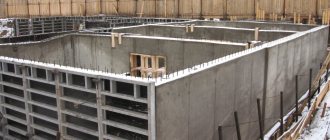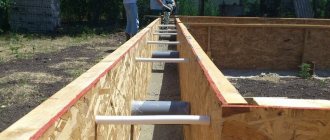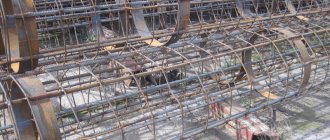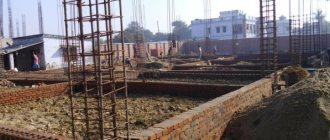Small panel formwork
- This is a type of formwork for monolithic construction. It consists of a steel frame and a metal or plywood deck, as well as elements that perform the function of connecting and supporting.
It is designed specifically for the construction of objects in special conditions. For example, if it is not possible to use heavy equipment on the site. Such equipment is relevant for concreting foundations and residential buildings.
Thanks to the widest variety of shields, you can easily implement the most non-standard ideas. For example, build columns and walls of non-standard and complex shapes.
Structural steel is used in the production of high-quality formwork systems. It is particularly durable, allowing them to withstand heavy loads. For heavy loads, you can choose formwork with additional stiffening ribs that strengthen the frame.
Such equipment is subject to anti-corrosion treatment and often has a special coating, so that special storage conditions are not required and a long service life is ensured.
Scope of application
Small panel formwork can be used in the construction of a wide variety of objects. In addition to walls and foundations, such structures are used, for example, in the construction of:
- columns;
- floors;
- curbs, concrete sidewalks;
- benches, barbecues, etc.
Installation of small panel formwork: main elements
Most often, collapsible structures of this type are used in construction. Such formworks consist of:
- corner and linear panels;
- composite trusses and scrums;
- supporting pillars (in formwork for building floors);
- connecting and fastening elements.

The technical and economic indicators of an adjustable structure may have, for example, the following:
- turnover - 100 times;
- reduced mass - 65 kg/m2;
- installation labor intensity is average - 0.6 man-hours per 1 m2.
These are the characteristics that distinguish one of the formworks, developed back in Soviet times by Gosstroy specialists. Nowadays, more modern designs of this type can be used. For example, small-panel steel formwork “Quarta” has the following characteristics:
- turnover for a steel frame - 100 cycles;
- for deck - 60 cycles;
- The average weight of the shield is 26 kg/m2.
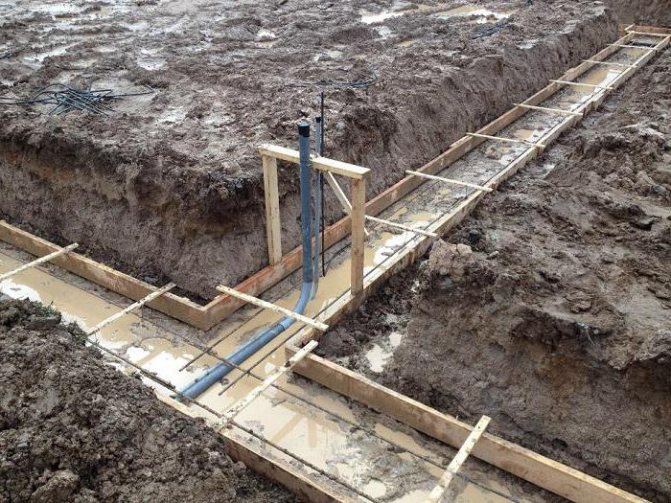
Modern industrial formwork can be made from wood, steel or other materials. To obtain a clean and smooth surface of the object being built, such structures use an additional element - a deck. It is made either from moisture-resistant plywood or tin. The deck is usually attached to the main elements of the formwork using self-tapping screws.
Premium quality panel formwork
Price including VAT in rubles
| Name | Up to 100 thousand | from 100 to 300 thousand | from 300 to 500 thousand | From 500 thousand |
| Linear shield 1.2x3.0m | 13 745 | 13 495 | 13 120 | 12 870 |
| Linear shield 1.0x3.0m | 12 546 | 12 318 | 11 975 | 11 747 |
| Linear shield 0.9x3.0m | 11 322 | 11 116 | 10 807 | 10 601 |
| Linear shield 0.8x3.0m | 10 646 | 10 453 | 10 162 | 9 969 |
| Linear shield 0.7x3.0m | 9 622 | 9 447 | 9 185 | 9 010 |
| Linear shield 0.6x3.0m | 9 173 | 9 006 | 8 756 | 8 589 |
| Linear shield 0.5x3.0m | 8 322 | 8 171 | 7 944 | 7 792 |
| Linear shield 0.4x3.0m | 7 698 | 7 558 | 7 348 | 7 208 |
| Linear shield 0.3x3.0m | 6 797 | 6 674 | 6 488 | 6 365 |
| Linear shield 0.2x3.0m | 5 893 | 5 786 | 5 625 | 5 518 |
| Internal corner panel 0.3x0.3x3.0m | 9 834 | 9 655 | 9 387 | 9 208 |
| Internal corner panel 0.5x0.5x3.0m | 13 971 | 13 717 | 13 336 | 13 082 |
| External corner board 0.5x0.5x3.0m | 14 857 | 14 587 | 14 182 | 13 912 |
| External corner panel 0.6x0.6x3.0m | 15 657 | 15 372 | 14 945 | 14 661 |
| External corner panel 0.3x0.3x3.0m | 12 459 | 12 232 | 11 893 | 11 666 |
| Universal shield 1.2x3.0m | 18 859 | 18 516 | 18 002 | 17 659 |
| Universal shield 1.0x3.0m | 17 495 | 17 176 | 16 699 | 16 381 |
| Universal shield 0.8x3.0m | 14 509 | 14 245 | 13 849 | 13 585 |
| Universal shield 1.1x3.0m | 18 238 | 17 906 | 17 409 | 17 077 |
| Universal shield 0.7x3.0m | 12 158 | 11 937 | 11 606 | 11 385 |
| Universal shield 0.9x3.0m | 16 008 | 15 717 | 15 281 | 14 990 |
| Universal shield 0.6x3.0m | 11 781 | 11 566 | 11 245 | 11 031 |
Types by assembly method
Most often, in construction, demountable panel structures are used. But sometimes modular formworks of this type are also used for pouring monolithic structures. Such structures can withstand a concrete mixture pressure of 40 kN/m2. Their main feature is that they consist of elements of a fixed size. Modular structures are usually made from laminated plywood with a thickness of more than 18 mm. The advantage of this type of formwork is that when individual elements wear out, they can be replaced with new ones. With the help of such systems, surfaces of any configuration can be easily formed. Most often, modular formworks are used in the construction of private houses and public buildings for various purposes.
The advantage of collapsible formwork is, first of all, that it can be installed in both planes. Moreover, such structures are assembled and disassembled very quickly. If necessary, even curved shapes can be filled using this type of formwork. For example, these are the structures that are used in the construction of round concrete porches.
Large panel formwork
The use of large-panel formwork is advisable for creating large and monolithic concrete walls. Its dimensions can range from 3 to 20 square meters. The main components are a metal frame, the rigidity of which is achieved using special hot-dip galvanizing treatment, as well as a deck, which is made of three-layer plywood coated with synthetic resins.
As a rule, panels with a height of 270 centimeters and a thickness of 2.1 cm are used in construction. For the construction of industrial facilities, structures with a height of 3.3 meters are used. At the same time, for the normal installation process it is necessary to use cranes with a large lifting capacity.
How to install a modular design
The assembly of this type of formwork begins with a corner element. Next, adjacent blocks are attached to the latter. In this case, connecting elements with special springs are used. The “walls” of such formwork are assembled using tie bolts. The supporting frame is formed from two panels installed opposite each other. The latter are connected using special locks. The end and top parts of the shields are fastened together using spacer strips. In this case, locks are also used for fixation.
Installation of small-panel industrial adjustable formwork
Installation of this type of structure is also carried out in several stages:
- an auxiliary structure is installed (using corners and panels);
- adjacent panels are installed;
- adjacent panels are secured using spring hooks;
- The assembled box is placed in the design position and straightened.
The concrete mixture is usually poured into the formwork using an internal vibrator.

Formwork elements
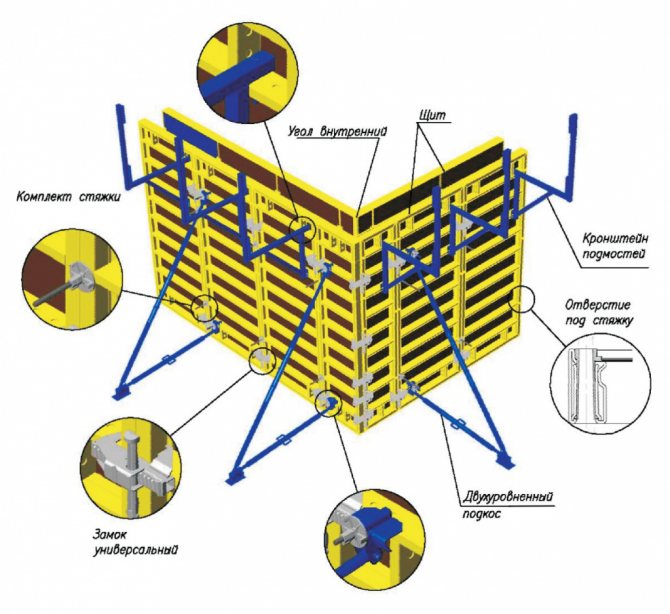
The package includes the following items:
- Shields. This is the basis of the design. The smoothness of future concrete walls depends on it. Shields come in different sizes: they are selected taking into account the specifics of the project. They also come in different types: linear, universal, angular and hinged.
- Fasteners. These are, as a rule, screws or locks that connect the formwork elements.
- Support equipment. Its function is to ensure maximum structural stability. When pouring concrete into forms, the formwork can withstand enormous loads. Special equipment does not allow it to deform.
The advantage of formwork is that the structure can be completed if necessary.
Standard Requirements for Dimensions of Industrial Structures
Many manufacturers produce small-panel formwork. But in their manufacture, in any case, GOST standards must be observed. So, the area of one formwork panel should not, for example, exceed 3 m2. The minimum weight is 50 kg. These dimensions make it possible to install the structure without the use of special equipment.
The dimensions of industrial small-panel formwork of the same brand can be different. For example, for the popular Framax design, the height indicator can be 135, 270 or 330 cm. In terms of width, there are five standard sizes of shields for structures of this brand - 30, 45, 60, 90 and 135 cm.
Pros and cons of small panel formwork
The widespread use of small-panel formwork is due to its undoubted advantages. Its main advantages:
- versatility, allowing you to assemble different shapes with high geometric accuracy;
- combinatorial, factory-made kits can be combined in different combinations, while parts of small-panel formwork can be combined with parts of large-panel kits;
- convenience, the small size of the boards allows you to assemble forms even in the most inconvenient places;
- financial benefits, light weight and modest dimensions of the elements make it possible to do without the use of lifting equipment. Individual parts and even assembled blocks weigh no more than 50-60 kg, so they can be moved manually without the help of cranes;
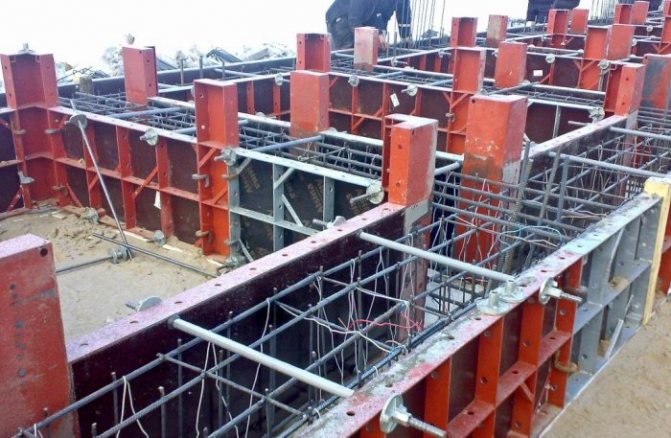
- it’s easy to organize storage; you don’t need to use special storage facilities to place elements;
- The presence of special fixing elements in the kit allows you to assemble forms that are durable and reliable.
The only significant drawback is the relative complexity of installation, especially if you need to assemble large forms.
Homemade options
Very often, small-panel formwork is used for foundations and monolithic walls and in private construction. Industrial structures of this type are most often used by small, medium and large construction organizations. When building houses, private individuals usually use much cheaper homemade formwork. You can use any available materials for this design. Making it with your own hands is quite simple.
Homemade formwork, in turn, is also divided into two main types - conventional and adjustable. The advantage of the latter type of structure is the saving of material.
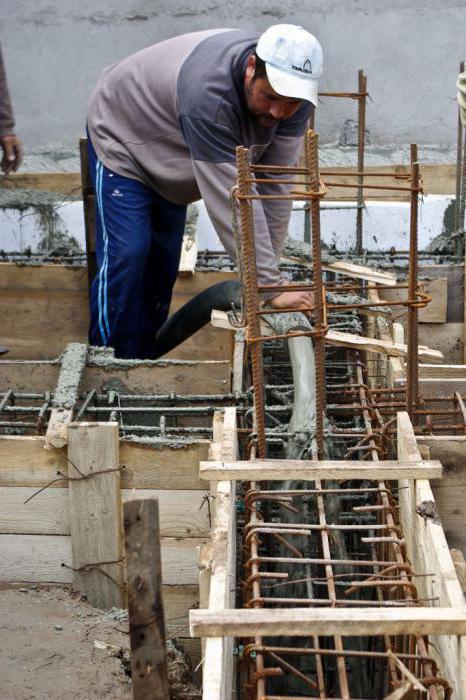
Homemade collapsible small-panel formwork usually consists of two panels and elements intended for their fastening. During the work process, it is moved around the perimeter of the object being built. The disadvantage of this type of construction is, first of all, that the building elements poured with its help are less durable and reliable.
Conventional stationary homemade collapsible formwork is installed around the perimeter of the entire facility being built. Its advantage is reliability and a more neat appearance of the finished structure. The disadvantage of such auxiliary equipment is the complexity of assembly/disassembly and the need to use a large amount of materials.
Design elements of homemade formwork
Such formworks can be mounted from a variety of materials. Shields are most often assembled from boards. They are fastened with beams. Tin can also be used to make shields. This material is often used, for example, for filling curved objects.
As spacers for homemade formwork, beams or reinforcing rods corresponding to the width of the length of the object being built can be used. The fastening of shields is most often done using steel wire. Sometimes bolted connections are also used. From the outside, the structure is additionally strengthened with struts made of beams.
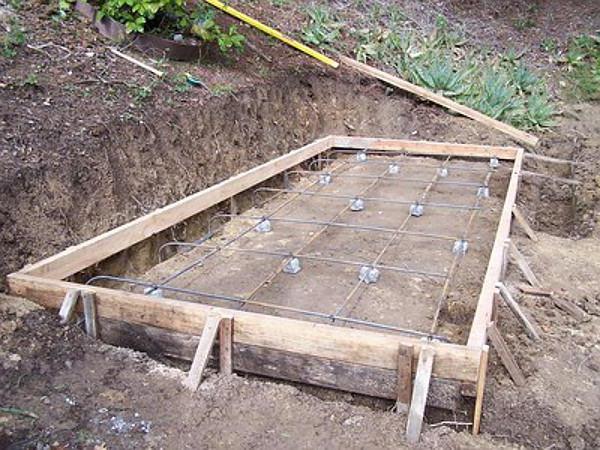
Dimensions of homemade formwork
The width of shields of such structures depends on the height of the object being built. According to the standards, the difference between these two indicators should not exceed 5 cm. Adjustable small-panel formwork for walls is most often assembled from two or three boards 150 mm wide. In this case, the structure turns out to be light enough so that it can be quickly moved around the perimeter of the object being built on its own.
The maximum permissible length of homemade formwork panels used for pouring walls and foundations is 3 meters. Boards for assembling such a structure must have a thickness of at least 20 mm. The beams for fastening them, spacers and struts are usually chosen with a cross-section of 40x40 mm. The minimum thickness of sheet metal for assembling such formworks is 1-2 mm.
How can you build formwork with your own hands?
For small private construction of foundations and load-bearing structures, you can easily make the formwork yourself, since buying or renting small-panel formwork will not cost much, and adjustable large-panel formwork will not be useful at all.
You need to start by choosing materials for formwork with your own hands.
If you need to make a universal budget option, then give up metal and plastic. This is an expensive and complex type of DIY frame construction. Wooden modules from edged boards 40/200 mm, as well as bars 100/100, 40/40, 20/20 mm are best suited.
The work of making such formwork with your own hands proceeds approximately according to the following algorithm:
- It is necessary to make a universal collapsible and portable shield no more than half a meter in height (for ease of movement around the facility). It is recommended to make a collapsible-portable panel no more than 1.5 m in width, but everything, of course, depends on the type of structure being poured. Outside these boards, at the top, bottom and in the middle, you need to nail wooden beams (they will hold the modules together). To prevent concrete mortar from sticking to the surface, the panels are covered with polyethylene or painted with an oily liquid.
- Markings of future load-bearing fences are applied to the site.
- Next, 100 mm guide bars are made. They are installed every 1-2 m, at the points where the portable part joins. The height of these guides should exceed the height of the wall being poured by 30 mm. They are fixed directly into the ground.
- Then you install the transverse wooden fasteners and spacers with your own hands.
- After the reinforcement has been installed and the concrete solution has been poured and dried, the collapsible wooden formwork panels are moved to a higher level, and then also strengthened with connecting transverse elements. The upper level should be slightly over the already finished lower layer of the wall.
